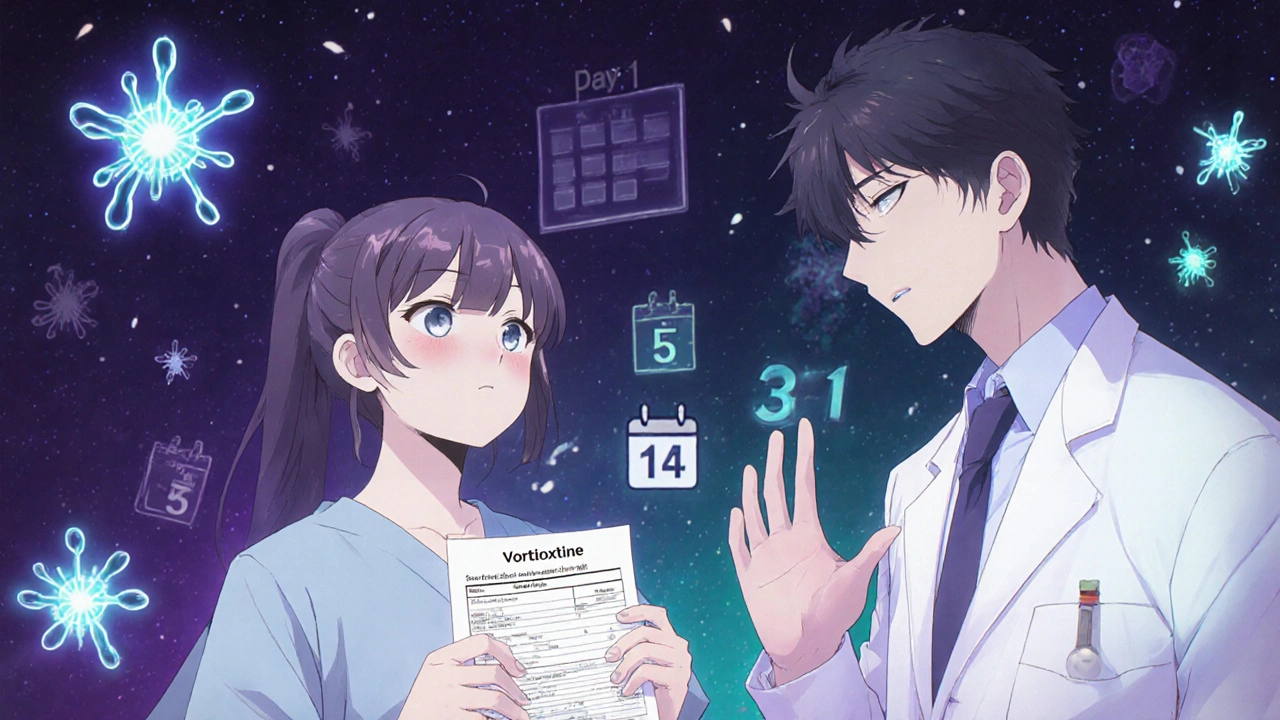Vortioxetine Nausea Risk Calculator
Personal Risk Assessment
Why nausea happens with vortioxetine
When you start taking vortioxetine (brand name Trintellix), nausea is the most common reason people feel uneasy-sometimes so much that they consider stopping the medication. About 1 in 3 people experience it, especially in the first week. It’s not a sign the drug isn’t working. In fact, it’s often the opposite: the medication is doing exactly what it’s supposed to do-boosting serotonin levels in your brain and gut.
Vortioxetine works differently than older antidepressants. It doesn’t just block serotonin reuptake like SSRIs. It also interacts with multiple serotonin receptors, including 5-HT3, which normally helps control nausea. But here’s the twist: even though it blocks 5-HT3 receptors in the brain, the sudden flood of serotonin in your digestive tract before the body adjusts can still trigger nausea. That’s why it hits hardest in the first few days.
It’s not random. The more you take, the worse it gets. At 5 mg daily, nausea affects about 15% of people. At 10 mg, it jumps to 26%. At 20 mg, nearly 3 in 10 people feel sick. Compare that to just 8% of people on a placebo. And while it’s uncomfortable, it’s almost always temporary. Most people see improvement within 9 to 16 days. About 74% of those who experience nausea find it fades completely within two weeks.
Who’s most at risk for severe nausea
Not everyone reacts the same way. Some people barely notice it. Others feel like they can’t keep anything down. Women report nausea at 1.7 times the rate of men, according to FDA data. People with pre-existing stomach issues-like irritable bowel syndrome or chronic nausea-have a much higher risk. One study found that in this group, nausea rates jumped to 41%.
Age matters too. Teens and young adults are more likely to have strong reactions. In clinical trials involving patients aged 7 to 17, nausea occurred in 38% of cases-much higher than the 26% seen in adults. That’s why vortioxetine isn’t approved for children and is only used off-label in younger patients when absolutely necessary.
Another big factor: what else you’re taking. If you’re on fluoxetine (Prozac) or other strong CYP2D6 inhibitors, your body can’t break down vortioxetine properly. That causes levels to spike, increasing nausea risk by 62%. Even over-the-counter meds like certain antihistamines or cough syrups can interfere. Always tell your doctor everything you’re taking before starting vortioxetine.
How to reduce nausea from day one
The best way to avoid severe nausea isn’t to tough it out. It’s to start low and go slow. Clinical guidelines recommend beginning with 5 mg per day for at least one week-sometimes two-before increasing to 10 mg. This simple step cuts nausea-related dropouts by 40%. Many patients who tried starting at 10 mg right away quit. Those who started at 5 mg stayed on the medication and felt better over time.
Timing matters too. Taking vortioxetine with a full meal reduces nausea by more than half. One Cleveland Clinic study showed 63% of people had fewer symptoms when they took it with food, compared to only 29% who took it on an empty stomach. Don’t just eat a cracker. Eat something solid: toast with peanut butter, oatmeal, scrambled eggs. Avoid greasy, spicy, or overly sweet foods-they make it worse.
Some people swear by ginger. Taking 1 gram of ginger daily (in capsule form or as tea or chews) reduces nausea severity by 44%, according to the same study. Peppermint oil aromatherapy also helps-just inhaling the scent a few times a day can cut the number of nausea episodes by more than three per week. These aren’t magic fixes, but they’re low-risk and backed by real data.

What to do if nausea won’t go away
If you’re still feeling sick after two weeks, don’t assume you have to suffer. There are effective, safe options. The first step is usually an over-the-counter medication like dimenhydrinate (Dramamine). It’s not meant for daily use, but taking 25 to 50 mg when nausea hits can help you get through the day. About 78% of users find it helpful.
If that’s not enough, your doctor may prescribe ondansetron (Zofran). This is the go-to for chemotherapy-related nausea, and it works just as well for vortioxetine. A typical dose is 4 mg twice a day. Studies show it reduces nausea in 89% of cases. It’s safe for short-term use and doesn’t interfere with vortioxetine’s antidepressant effects.
Prochlorperazine (Compazine) is another option, but it’s usually saved for the toughest cases. It can cause drowsiness or muscle stiffness, so it’s not first-line. Most people never need it.
One thing to avoid: switching to another antidepressant too soon. Many people think, “If this one makes me sick, maybe another will be better.” But the truth is, most antidepressants cause nausea at first. Sertraline and duloxetine have similar rates. The advantage of vortioxetine isn’t that it causes less nausea-it’s that the nausea fades faster and doesn’t come back. Plus, it’s one of the few antidepressants proven to improve thinking, memory, and focus in people with depression.
Real stories: How people got through it
On Reddit, a user named NeuroChem89 shared their experience: “Started Trintellix 10mg for MDD-threw up twice the first week. Couldn’t keep food down. My psychiatrist told me to drop to 5mg for two weeks, take it with dinner, and chew ginger candies. By week three, I felt like myself again. The depression didn’t come back.” That story isn’t rare. Thousands of users report the same pattern: bad at first, better by day 10, gone by day 14.
On GoodRx, people who rated vortioxetine positively often wrote: “Nausea went away after 10 days. My mood kept getting better.” But the negative reviews tell a different story. About 19% of those who quit said nausea never improved-even after three months. These are usually the people who started too fast, didn’t eat with the pill, or didn’t try any supportive measures.
The key takeaway? It’s not about whether vortioxetine causes nausea. It’s about how you manage it. The people who stick with it aren’t the ones who ignored the side effects. They’re the ones who worked with their doctor to adjust timing, dose, and lifestyle.

When to call your doctor
Most nausea is mild and temporary. But if you’re vomiting more than twice a day, losing weight, feeling dizzy, or having signs of dehydration (dry mouth, dark urine, extreme tiredness), contact your provider right away. Also, if nausea lasts longer than three weeks, it’s not typical. That could mean you’re a slow metabolizer of the drug, or you’re taking something that interferes with it.
Genetic testing for CYP2D6 enzyme activity is now part of the American Psychiatric Association’s 2023 guidelines. If you’re a poor metabolizer, your body processes vortioxetine too slowly, leading to higher levels and worse side effects. In those cases, a lower dose or a different medication may be better.
Don’t stop vortioxetine cold turkey. Even if you feel sick, stopping suddenly can cause withdrawal symptoms like dizziness, anxiety, or brain zaps. Talk to your doctor. They can help you taper slowly or switch to another option if needed.
What to expect long-term
Here’s the good news: once the nausea fades, most people feel better than they have in years. Real-world studies show that 68% of people stay on vortioxetine for at least a year-higher than the 61% rate for SSRIs. Why? Because the benefits keep growing. Unlike other antidepressants, vortioxetine improves not just mood, but memory, attention, and decision-making. For people who struggle with brain fog along with depression, it’s often the best choice.
And the drug is evolving. Lundbeck is testing a new extended-release version that releases the medication more slowly, reducing the peak concentration that causes nausea. Early results show nausea dropped from 28% to 17% without losing effectiveness. That version could be available by late 2026.
Right now, vortioxetine isn’t the easiest antidepressant to start. But for many, it’s the one that finally works. The nausea is a hurdle, not a dealbreaker. With the right approach, you can get past it-and find relief you didn’t think was possible.







Rebecca Parkos
November 2, 2025 AT 00:08Bradley Mulliner
November 2, 2025 AT 00:12Marshall Washick
November 3, 2025 AT 01:14Ted Carr
November 4, 2025 AT 09:54Reginald Maarten
November 4, 2025 AT 10:26Neal Burton
November 5, 2025 AT 12:32Abha Nakra
November 7, 2025 AT 11:58Melissa Delong
November 7, 2025 AT 22:57Rahul hossain
November 9, 2025 AT 04:31